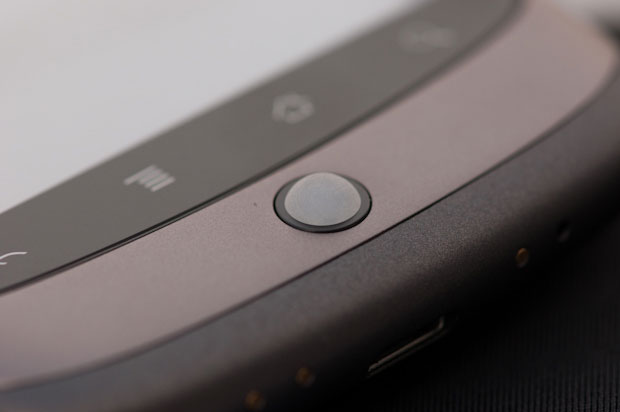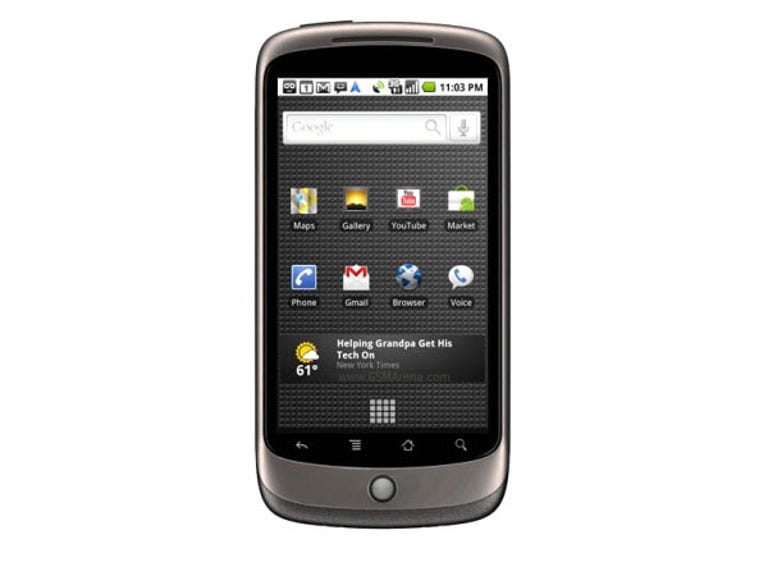 Why You Can Trust CNET
Why You Can Trust CNET Google Nexus One review: Google Nexus One
Google's Nexus One may not be the iPhone killer, but it offers a comparable alternative to Apple's smartphone.
Prettier than in pictures
We heard you groaning the day Google announced the Nexus One: how could Google's iPhone-killer seriously be so bland? How could its two-tone grey chassis compete for a place in our hearts with the glossy Apple goddess? Interestingly, this is one of the rare cases of the product being sexier in real life than it is in product images. The Nexus One looks and feels fantastic, the Teflon-coated battery cover feels soft to the touch, and its 120x60x11.5mm dimensions feel just right.
The Good
The Bad
The Bottom Line
The Nexus One shares more physically with the iPhone than might be at first apparent. Both position the volume rocker on the left-hand side (when facing the screen), both have a screen lock key and headphone socket on top and charging at the bottom. Where Apple's positioned the iPhone's single home key, Google has put a trackball and four touch-sensitive Android specific controls.

The Nexus One's trackball control
(Credit: Josh Lowensohn/CNET.com)
While we're comparing Apples and Googles the Nexus One takes the cake in regards to its display. Its 3.7-inch screen is slightly taller but also slimmer than the iPhone's, but its WVGA resolution and AMOLED screen technology blow the competition away in terms of clarity of image, colour and contrast. In terms of touchscreen sensitivity the Nexus One does an adequate job, though we have found it difficult to register an accurate response at the bottom of the screen on our test unit, a problem we noticed most when trying to use the space bar on the on-screen keyboard.
Talk the talk
The Nexus One runs Android version 2.1, the latest version to be made commercially available at this time, and it brings a few notable extras not available on previous handsets running Android. The most significant of these upgrades is the integration of Google Voice speech-to-text anywhere that would otherwise use the keyboard. That's right, in SMS messaging, in your Facebook status updates, in Twitter, etc. In theory this is a massive step forward to mobile communications, a free speech-to-text service is what mobile phones have needed since the first SMS was sent, but in practice it still needs a little Google spit and polish. During our tests it recognised some voices better than others and struggled with the Australian accent on more than one occasion.
There are also several interface tweaks to mention, including the Nexus One's funky live wallpapers and dedicated screen modes for in the car and as a bedside clock. The live wallpapers are your new best friend at dinner parties, with 10 animated backgrounds to choose from with a couple that respond to touch and a couple that respond to the tempo of music you play through the phone's media player. The in-car mode is a little more useful, breaking down the interface into five easy-to-read options including a voice search mode to imitate a new Google Map location search. You may have heard about free turn-by-turn direction for owners of the Nexus One, but unfortunately that only applies to people navigating in the US.
Power hungry
If speed is your game then the Nexus One's 1GHz Snapdragon processor should have you covered. From the moment we booted the Nexus One we saw the difference with a significantly faster boot time than any Android we've seen before it. The speed bump continues through the rest of the phone's main applications — cruising the menus and loading apps — with actual processing speed assisted by the illusion of fluidity created by various transition animations. For example, when you select the main application menu from the home screen the menu appears to fly in and overlay the screen, which looks much better than the phone pausing for a moment and the menu simply appearing after the load time.
The 1GHz processor does take its toll on battery life however, and matched with the large, high-resolution screen, the Nexus One is anything but the Energizer bunny. To achieve a day's battery life we had to cut down our usage to what could be described as low-to-moderate use; GMail set to an hourly push cycle, a half-hour or less of Wi-Fi web browsing, some music playback and standard calls and messaging. People hoping to use the Nexus One for business purposes should be prepared to purchase a car charger and expect to leave the phone plugged in when stationed at your desk in the office.
Big shot
One area we didn't expect to be blown away with was the phone's 5-megapixel camera, even though we'd heard about its LED flash and touchscreen auto-focus feature. In some respects we were right not to get our hopes up too high, close inspection of the photos taken by the Nexus One reveal a lack of detail and some pixellation, but if we take off our camera-snob-goggles the photos are just fine for their purpose. The colours are bright and the camera performs well in low light and if you're posting to Facebook or Picasa we don't think you'll be too disappointed.
The Nexus One ships with a 4GB microSD card. (Credit: Josh Lowensohn/CNET.com)
Your photos will be stored on the 4GB microSD memory card included in the box, but apps you download from the app market will not. This means you have about 200MB to use for apps which is utterly ridiculous. This problem isn't new to Android devices, and this should have been the firmware release to clear up this issue. As it stands, the Android Market faces a difficult future, especially in regards to mobile gaming, unless Google addresses this problem immediately.
Overall
We've seen several Android phones recently; the Hero, the Milestone and the Tattoo to name a few, but the Nexus One streaks ahead with thanks to the firmware 2.1 upgrade and the handset's first class performance. This isn't just the best Android phone to date, this is the benchmark to which all Androids that follow must live up to (and we can't wait to see HTC's Sense UI running on a handset of this calibre). As compared to the rest of the mobile world the Nexus One is a major contender. It may not eclipse the iPhone in terms of performance or features, but it does offer a comparable alternative to the darling of Cupertino.
The Nexus One isn't yet available through mobile carriers in Australia, but those interested in beating the carriers can grab one from online vendor Mobicity.com.au.


